Chest
Are you a guy who wants to develop a big, muscular chest, or are you a lifter who's just curious about the best way to train your pecs? Either way, this section is for you.
No products in the cart
You May Also Like:




Get 10% on Your First Order claim now
Free U.S. shipping on all orders over $75
Are you a guy who wants to develop a big, muscular chest, or are you a lifter who's just curious about the best way to train your pecs? Either way, this section is for you.
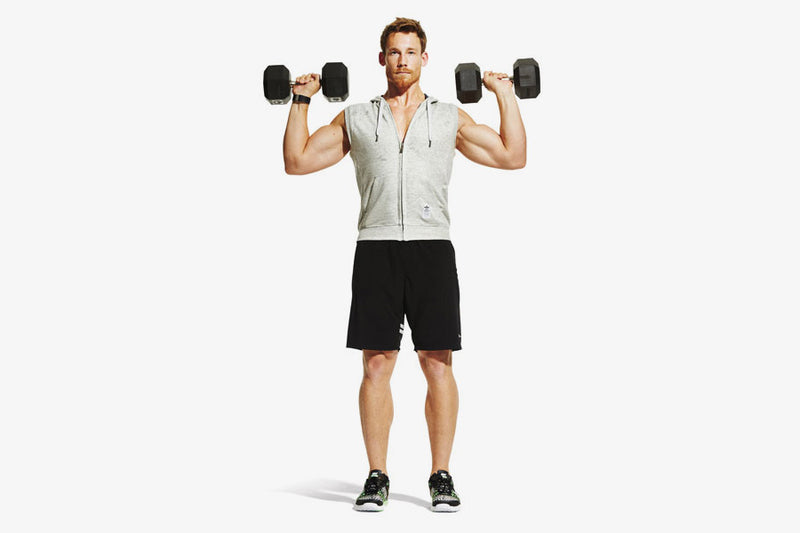
Exercise Description Target Muscle Group Chest Secondary Muscles Shoulders , Arms Exercise Type Strength Equipment Required Dumbbell Experience Level Beginner Compound/Isolated Compound Force Type Pull Target Muscles: Chest Standing Chest Fly Overview The main muscles targeted in standing chest flyes are the pectoralis major and minor. These muscles make up the bulk of the chest and are responsible for its shape and size. By working these muscles with chest flyes, you can develop a strong, toned chest. Additionally, standing chest flyes also work the shoulders and triceps. As such, they are a great exercise for developing upper body strength. How to Do It Start by standing with your feet shoulder-width apart and your knees bent. Hold a dumbbell in each hand at shoulder level with your palms facing in. From here, open your arms out to the sides and then bring them back together in front of you. Repeat this motion for the desired number of reps. Standing Chest Fly Tips First, be sure to keep a slight bend in your knees throughout the exercise. This will help you maintain balance and stability. Secondly, be sure to keep your core engaged and your back straight. This will help you avoid injuries and keep your form in check. Finally, be sure to keep your palms facing each other throughout the exercise. This will ensure that you are properly working the chest muscles. If you are new to this exercise, start with light dumbbells and gradually increase the weight as you get stronger. Additionally, be sure to perform the exercise slowly and with control. This will help you avoid injury and ensure that you are properly working the muscles.
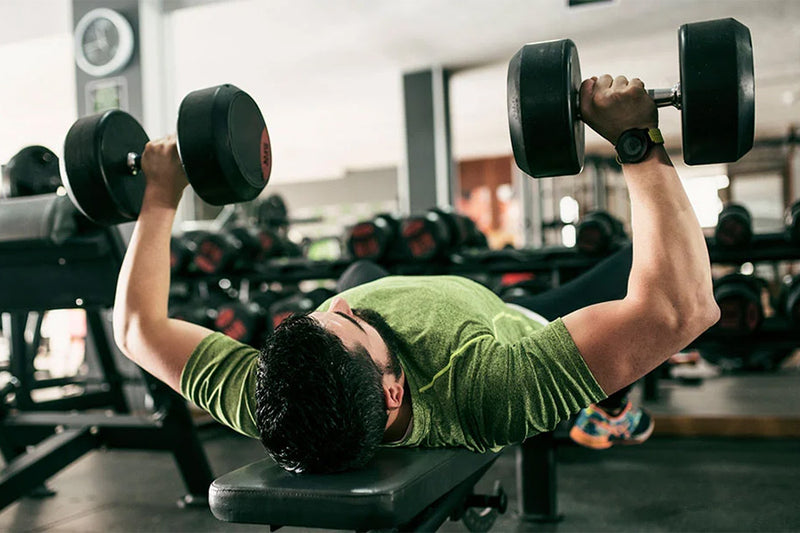
Exercise Description Main Target Muscles Chest Secondary Target Muscles Shoulder, Triceps Workout Type Strength Gym Gear Dumbbell Fitness Level Intermediate Compound/Isolated Isolated Power Move Push Target Muscles: Chest Dumbbell Chest Press Overview The dumbbell chest press is a great exercise to build your upper body strength. With dumbbells, you need to be more focused while performing exercises. You need to stabilize the weight in each hand, and hence, the exercise works great for both sides of your chest. The exercise helps in developing strength in your entire torso. It also prepares you well for other exercises such as overhead press, barbell bench press, etc. The exercise also helps in improving your range of motion and induces massive muscle gains. How to Do It Lie on a bench with a dumbbell in each hand. Your hands should be on the sides of your shoulders. Press your feet into the ground. Press the weight above your chest by extending your arms completely. Bring them down, and you can lower them below shoulder level. Do the same for ten reps. Dumbbell Chest Press Tips Avoid colliding your dumbbells at the top of the movement. Make sure that your back is not arching. You must press your feet to the ground too. Start with a lightweight and increase it gradually. Pay attention to your breathing throughout the exercise.
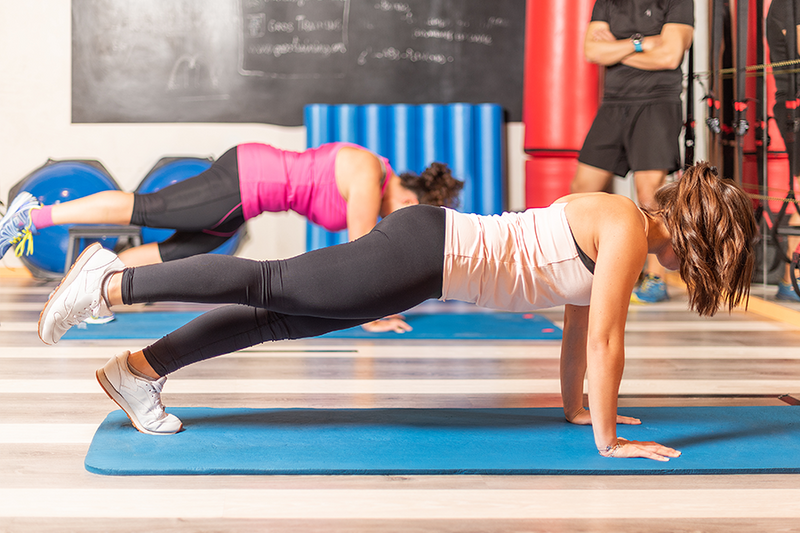
Exercise Description Main Target Muscles Chest Secondary Target Muscles Abs, Shoulders, Triceps Workout Type Strength Gym Gear Bodyweight Fitness Level Intermediate Compound/Isolated Compound Power Move Push Target Muscles: Chest, Core, Shoulders, Triceps Walk the Floor to Pushup Overview The walk the floor to pushup is a slight variation of traditional pushups. It’s a plyometric exercise that targets the chest, shoulders, core and triceps. This workout is effective for pushing muscles of the upper body. Its purpose is to strengthen the upper parts of the body. How to Do It? Place your hands on the floor by bending at the hips. Your shoulders should be width-apart with a couple of inches in front of your feet. With your body in a pushup position, walk your hands forward and do a pushup. Now get back to standing by walking your hands to your feet. Walk the Floor to Pushup Tips First of all, take a standard pushup position. Your hands should be on the ground under your shoulders. Start the push up by bringing your right feet 6 inches forward and performing a push up. Do the same for the left hand and feet, and do a pushup. Repeat for desired number of reps
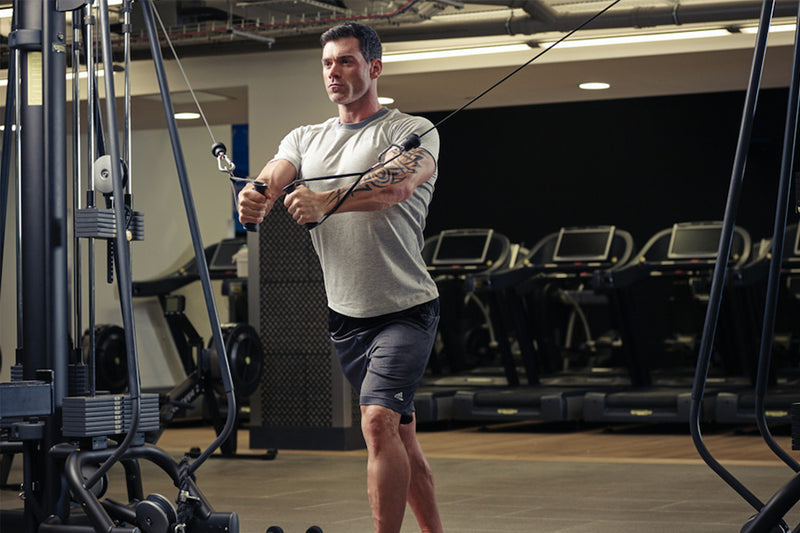
Exercise Description Main Target Muscles Chest Secondary Target Muscles Back Workout Type Strength training Gym Gear Pulley machine Fitness Level Beginner Compound/Isolated Isolated Power Move Pull Target Muscles: Chest Cable Fly Overview The cable fly is a modified version of the chest fly. It involves the muscles of your chest, triceps, and shoulders and strengthens them. It is important to work on your core strength first before starting this exercise. Without core stability, you might not be successful in doing this. The cable fly is great for increasing the muscle mass in your chest. You can include this exercise in your chest, upper body, or full-body workouts. You need a pulley machine to do this exercise. How to Do It Set the pulleys at shoulder height and add weight to the stack. Grasp both handles with a neutral grip and take a step forward. Press into handles, flex the pecs, and extend your elbows. With a slight bend to your elbows, move your arms to open them and take them to the side; this will help stretch the pecs. Return to starting position while flexing pecs and bringing both arms to your chest. Slowly lower your arms to the starting position. This makes one complete rep. Cable Fly Tips Avoid squeezing the handles too much as it will reduce the engagement of your pecs. Do not allow your back to arch and keep your core engaged throughout the exercise. Avoid banging the handles together at the peak movement.
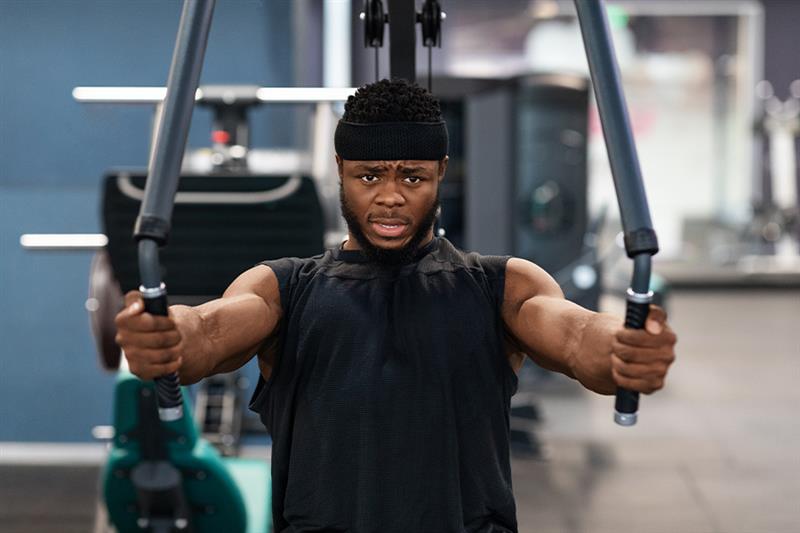
Exercise Description Main Target Muscles Chest Secondary Target Muscles Arms and Pectoralis Workout Type Strength Gym Gear Pec Deck Machine Fitness Level Advanced Compound/Isolated Compound Power Move Pull Targeted Muscle: Chest Pec Deck Workout Review Pec Deck, an exercise machine, specifically works the chest and its supporting muscles, strengthening not just the chest but the entire upper body. Pec deck engages arms and shoulders in order to activate and challenge the chest muscles. This results in an overall strengthening effect. How to Do It? Select the appropriate weight for the machine. Sit on the platform. Press your back firmly against the back of the platform with your feet flat on the floor. Grab the handles and place your forearms on each pad. Bend your arms at a 90° angle and keep your elbows at chest level. Gripping the pec deck handles, pull your arms toward your body while contracting your pectoral muscles. Bring the handles or arm pads in front of your chest, hold the position for a few seconds before slowly releasing back to the starting position. Repeat the desired number of reps. Pec Deck Workout Tips Exhale as you pull the handles toward your chest and inhale while you bring the handles back to starting position. If the workout is too intense, go with less weight to prevent injury. Your last rep should be difficult to complete, but not so much that you can't even maintain balance.
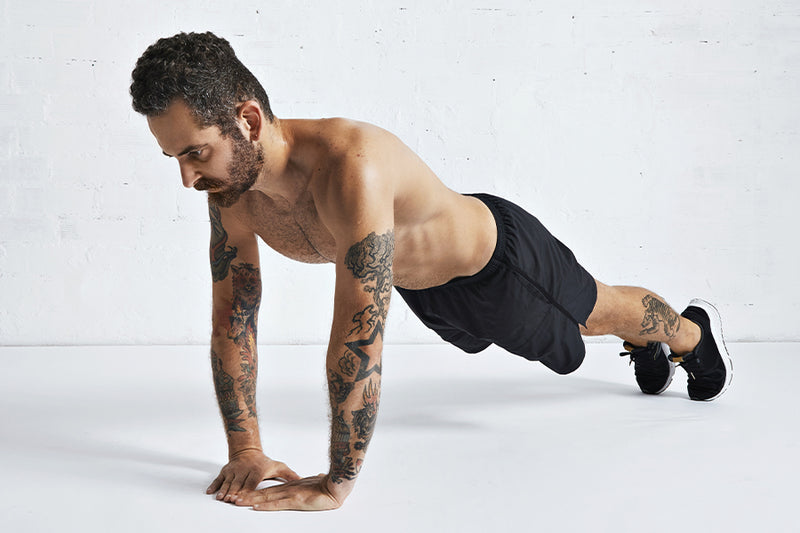
Exercise Description Main Target Muscles Triceps and Chest Secondary Target Muscles Biceps and Pectoralis Workout Type Strength Gym Gear Bodyweight Fitness Level Advanced Compound/Isolated Compound Power Move Push Target Muscles: Triceps and Chest Diamond Push Up Review The diamond push-up is a great way of targeting the triceps. All Push Ups engage the chest, shoulders and triceps anyway, but moving your hands a little closer than usual can do wonders for your triceps. In addition, the diamond push-up is a compound exercise that engages and activates muscles all over the body. Diamond push-ups are a considerable step up from the standard version in terms of difficulty. You would exhaust much sooner than when you do it with a wider angle. How to Do It Get on all fours with your hands placed close together under your chest. Place your index fingers and thumbs so they’re touching, forming a diamond shape, and extend your arms so that your body is elevated from the ground. It should form a straight line from your head to your feet. Lower your chest towards your hands Make sure you don’t flare out your elbows out to the sides and keep your back flat. Stop just before your chest touches the floor, then push back up to the starting position. This is one rep. Repeat the desired number of reps. Tips on Diamond Push-Ups Keeping your body straight is the key. Start small and gradually build stamina for more reps. It’s important to keep your hands under your chest; if they are placed outside of your shoulders, your joints will come under stress. Master the standard push-up before trying this version to avoid injury.
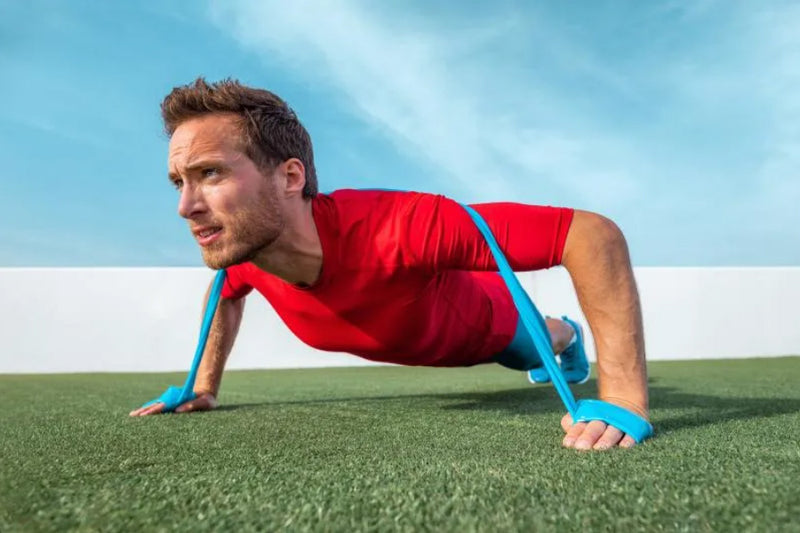
Exercise Description Main Target Muscles Chest Secondary Target Muscles Abs, Triceps, Shoulders Workout Type Strength Gym Gear Bands Fitness Level Beginner Compound/Isolated Compound Power Move Push Target Muscle: Chest Band Push Up Overview Most people are familiar with the traditional push-up, but the band push-up is a variation that offers a number of benefits. For one, it helps to maintain good form by keeping the elbows close to the body. This not only helps to prevent injuries, but also allows you to get the most out of the exercise. Additionally, the band push-up is a great way to build explosive power. The resistance provided by the bands challenges your muscles in a different way than bodyweight exercises, resulting in greater muscle growth. How to Do It Start in a standard push up position with your feet shoulder-width apart and your hands placed just outside of your chest. Place a band around your back and under your arms, making sure that it is tight but not too constrictive. Lower your body down to the ground, keeping your core engaged and your back straight. Press back up to the starting position, making sure to fully extend your arms at the top. Repeat for 8-12 reps. Push Up Tips Your arms should look like an arrow at the bottom, not a "T" Your spine should be straight throughout the exercise. Think of the pushup like a moving plank. To keep your ribcage neutral, squeeze your glutes and brace your abs before you descend. Keep your head down and keep your eyes on the floor. Think of your thumbs being pulled together as you complete the movement. This will increase the activation of your pecs. Do not allow your head to protrude forward. Your chest should touch your nose at the same moment as your nose. Try to push yourself as far off the ground as you can. Push through to the top of each repetition. Allow your shoulder blades and rib cage to move. Many people cut out repetition and don't reap the full benefits.
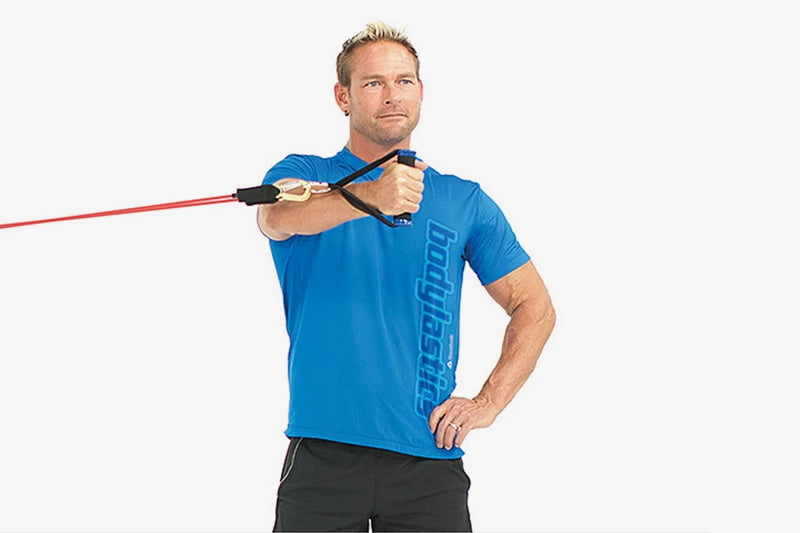
Exercise Description Main Target Muscles Chest Secondary Target Muscles Shoulders, Arms Workout Type Strength Gym Gear Band Fitness Level Beginner Compound/Isolated Compound Power Move Pull Target Muscle: Chest Single Arm Standing Fly Overview The single arm standing chest fly with resistance band is a great exercise for working the chest muscles. The resistance band provides resistance to the chest muscles as they contract, making the exercise more challenging. The single arm standing chest fly also helps to work the stabilizer muscles, which are important for posture and balance. In addition, this exercise can be performed with very little equipment, making it ideal for home workouts. How to Do Anchor a resistance band to a sturdy post or door at about chest height. Make sure the band is taut by giving it a good tug. Stand with your feet hip-width apart, and wrap the band around your left hand, holding it just above your wrist. Bend your elbow so that your arm is at a 90-degree angle and your palm is facing in. Keeping your elbow stationary, open your arm out to the side until your hand is in line with your shoulder. Reverse the motion, and bring your hand back to the starting position. Repeat for the desired number of reps. Exercise Tips To make this move more challenging, try doing it with one arm while holding a weight in the other hand. You can also increase the resistance by increasing the tension on the band.
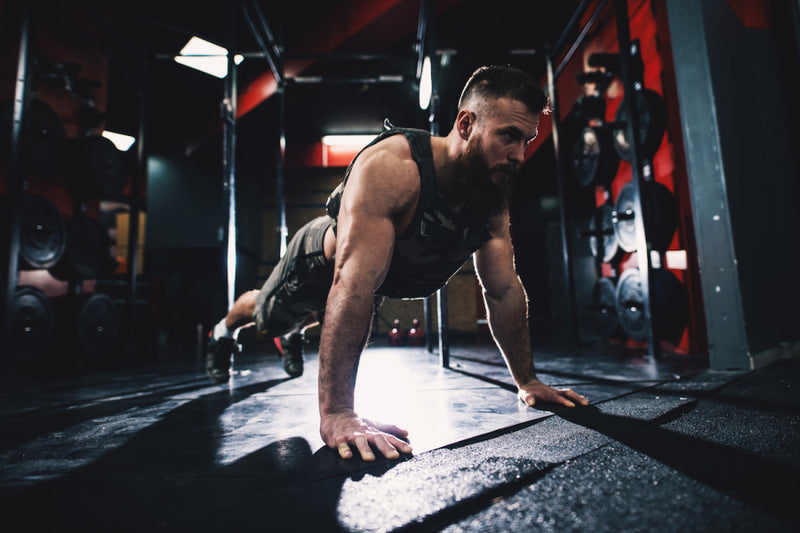
Exercise Description Main Target Muscles Chest Secondary Target Muscles Abs, Shoulders, Triceps Force Type Push Workout Type Strength Training Gym Gear Bodyweight, Weighted Vest Fitness Level Intermediate Compound/Isolated Compound Target Muscles: Chest, Abs, Shoulders, Triceps Paused Weighted Pushups Overview The paused weighted push up is a push up version and an exercise that targets the upper body's pressing muscles. The time under stress is increased by the isometric stop at the bottom of the halted push up. As a result, the stopped push up is a great next step after the push up. How to Do It? Place your hands below your shoulders with toes tucked and knees under hips in a quadruped pose on the ground. Stretch one leg at a time and push yourself up into a push-up situation with your legs straight, elbows open, and head in a stable position, staring at the ground. Retract your shoulder blades and free the elbows as you slowly descend towards the ground. Continue descending until your upper arms lie parallel to the ground or your chest reaches the floor, then hold for a defined length of time. Straighten your elbows and drive your hands into the floor to return to the beginning position. Repeat until you've completed the appropriate number of repeats. Paused Weighted Pushups Tips Using pauses increases the amount of time under pressure during the movement, making this an easy technique to improve a conventional pushup. In the lower position, your arms must form an arrow, not a "T." Consider the push up to be a moving plank. To maintain the ribcage straight, tighten your glutes and strengthen your abs before going down. Keep your chin low and avoid looking ahead. Squeeze your thumbs together while performing the exercise; this will boost pecs activation. Do not allow your head to thrust forward.
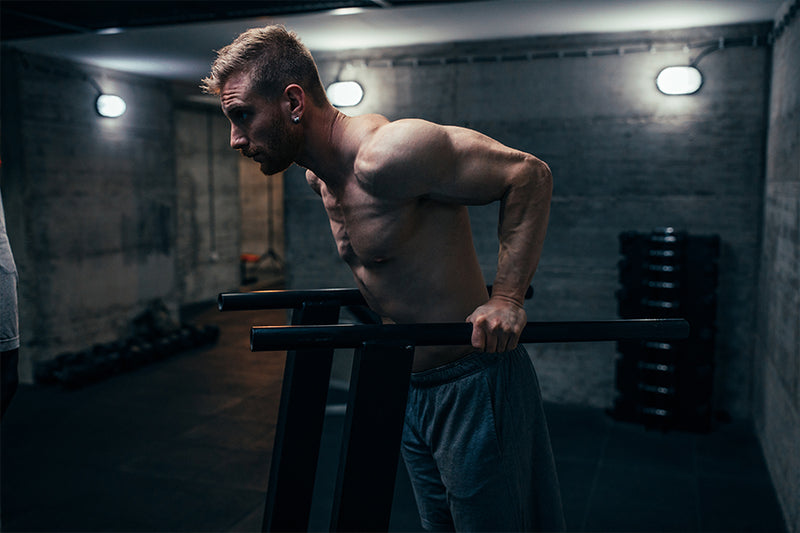
Exercise Description Main Target Muscles Chest Secondary Target Muscles Abs, Shoulders, Triceps Workout Type Strength Gym Gear Bodyweight Fitness Level Intermediate Compound/Isolated Compound Power Move Push Target Muscle: Chest Chest Dips Overview Chest dips are an excellent exercise that targets the triceps, shoulders and the chest muscles. This exercise is specifically effective for the lower region of the pecs. Whether you want to perform this exercise with bodyweight or free weights, this works spectacularly in both ways. This would be an excellent addition to chest exercises, push exercises, upper body exercises, and full-body workouts. How to Do It Position your hands in a neutral grip on the dip station. Unlock the elbows and lower the arms until they are parallel to the floor. Control the descent, then drive back to the initial position. Repeat for the desired number of reps. Chest Dips Tips You can perform these dips by staying upright or leaning forward. Brace the glutes and keep your legs straight, hanging down. You can position a box underneath handles if the station is not possible. If you don’t have a box either, you can jump in the position straight away. Keep your elbows just slightly away from being fully locked out. This would keep tension in your triceps.
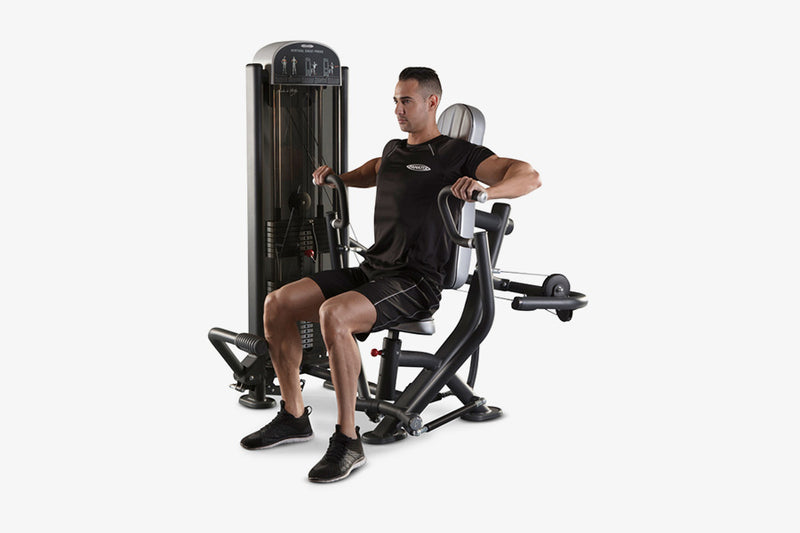
Exercise Description Main Target Muscles Chest Secondary Target Muscles Biceps Workout Type Strength Gym Gear Chest Press Machine Fitness Level Intermediate Compound/Isolated Compound Power Move Push Target Muscles: Pectoral Muscles Seated Chest Press Machine Overview The chest press machine works on your pectoral muscles. It also works on your biceps, deltoids, and latissimus dorsi. The seated chest press is a great exercise to include in your upper body workout routine. You also need better core stability to do the exercise. Since the pectoral muscles get weaker with age, it is necessary to work on them. In this exercise, you recruit the biceps and muscles of your shoulder and back. How to Do It Set the machine at the desired weight and adjust the seat to your height level. You should firmly press your feet to the floor and about shoulder-width apart. Grasp the handles with an overhand grip. Maintain a neutral wrist position. Push the bar outward until your arms are completely extended. Do not lock your elbows. Rest your head against the back support. Avoid moving your neck excessively. Pause here for a few seconds. Bend your elbows and return the bar to starting position. Seated Chest Press Machine Tips Make sure to breathe throughout the exercise. Start with a lighter load when you start with a chest press machine. Avoid stressing your shoulder joint too much. Control the arm extension and do not extend your arm too much. Avoid explosive movements and take them slowly.
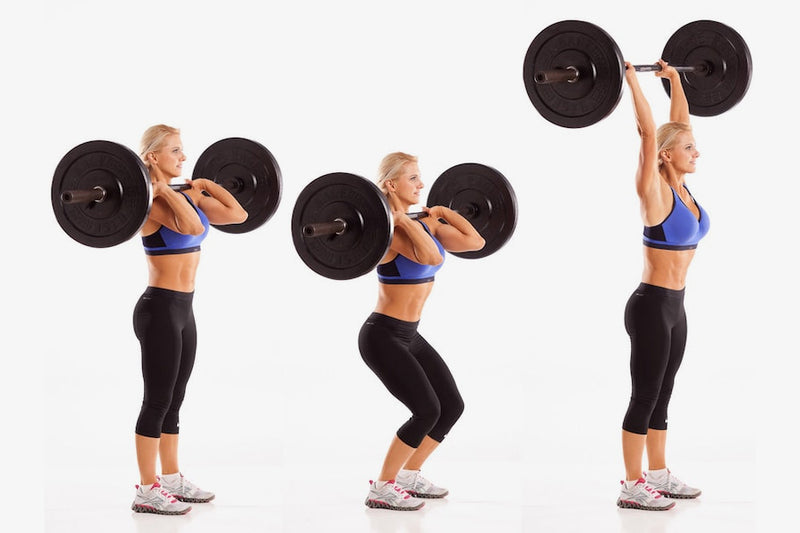
Exercise Description Main Target Muscles Chest, Triceps Secondary Target Muscles Glutes, Hamstrings, Core, Lower Back Workout Type Strength training Gym Gear Barbell, dumbbell Fitness Level Intermediate Compound/Isolated Compound Power Move Push Target Muscles: Pectoral Muscles, Triceps Push Press Overview Push press helps build your upper body strength. With this exercise, you can also get massive shoulders. It is a simpler version of the overhead press and plays a great role in conditioning your rotator cuff muscles which further helps you lift heavyweight. The exercise also helps activate many of your muscle groups. You will also see a great improvement in your other weightlifting exercises if you start practicing push press. The exercise also strengthens the muscles of your core. How to Do It Stand straight with your feet shoulder-width apart. Hold the bar with your fingers and point your elbows forward. Now rest the bar on the shoulders. Next, drop your lower body to a semi-squat position. You do not have to go to a complete squat. A slight bend in the knees would work too. Press up with your heels and drive the bar above your heads. Your arms should be straight and extended at this point. Pause here for a second and lower the bar to your chest. Do not arch your back and maintain a neutral spine. Push Press Tips Grip the bar strongly with the help of your fingers. Press it hard to activate the muscles. Make sure that you are not squatting too low. Only a slight bend in the knees will work. If you squat low, you might harm your knees. You can do push press with a pair of dumbbells too. With dumbbells, make sure that you stabilize the weight in each hand.
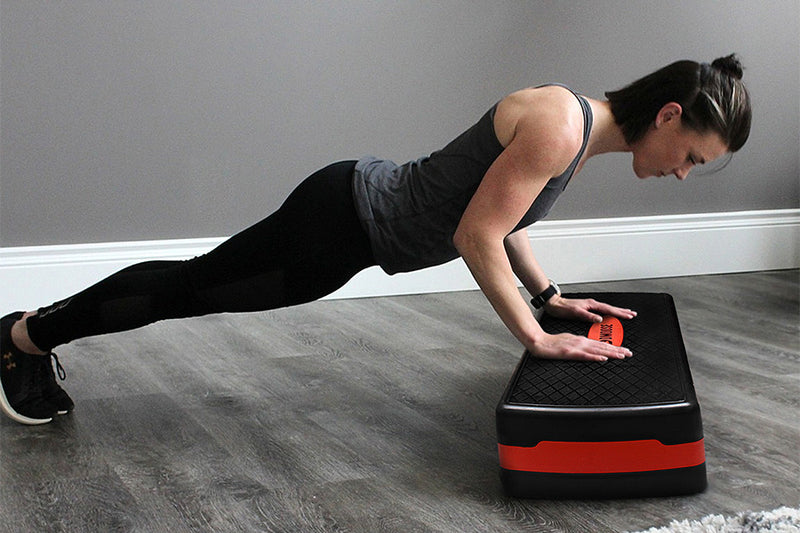
Exercise Description Main Target Muscles Chest Secondary Target Muscles Abs, Shoulders, Triceps Workout Type Strength Gym Gear Bodyweight Fitness Level Beginner Compound/Isolated Compound Power Move Push Target Muscle: Chest Incline Push-Ups Overview Incline push-ups are a variation of conventional push-ups that focuses primarily on the chest muscles. It also targets your abs, shoulders, and triceps as secondary muscle groups. This is a bodyweight exercise that requires the use of a bench press in order to incline the body. If you want to progress towards full bodyweight push-ups, this is an excellent exercise. It reduces stress on the shoulders, forearms, and wrists. It also improves your stability, form, and technique. How to Do It Place your hands on an elevated surface like a bench and walk your feet back until your body is at an incline. From there, lower your chest toward the surface and then press back up to the starting position. Keep your core engaged and be sure to not let your hips sag as you lower down. Repeat for the desired number of reps. Incline Push-Ups Tips Keep your spine as rigid as possible throughout the exercise. Brace your abs and squeeze your glutes as you perform the push-ups. Keep looking down and tuck in your chin. Put in your strength to pull yourself as far away from the floor as possible.
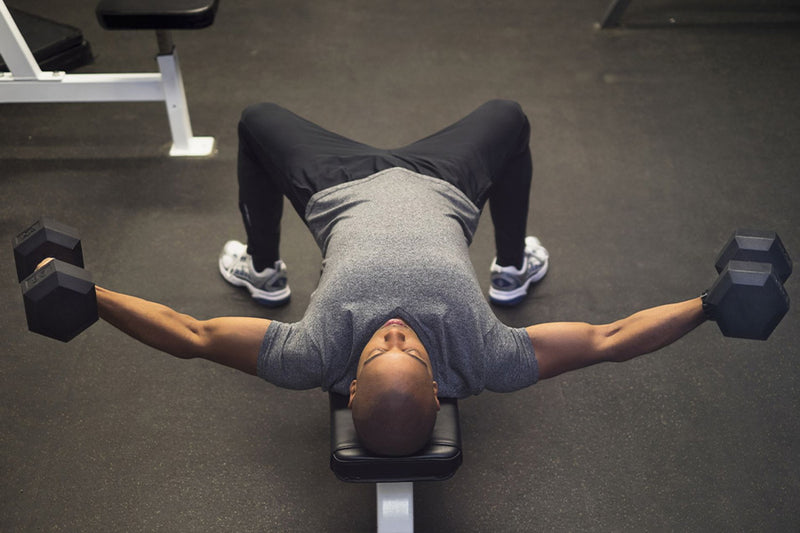
Exercise Description Main Target Muscles Chest Secondary Target Muscles Biceps, Lats, Lower Back, Shoulders Abs, Traps Workout Type Strength Gym Gear Dumbbell Fitness Level Beginner Compound/Isolated Isolated Power Move Push Target Muscle Group: Chest Dumbbell Fly Overview The dumbbell fly is a great exercise for targeting the chest muscles. This move can be done with a variety of weights, making it perfect for both beginners and experienced lifters alike. The dumbbell fly is often referred to as a classic movement because the purpose of the exercise is to isolate your chest for aesthetic reasons. Although the movement can be used to build a stronger bench press, it is not usually considered an increase in performance. This movement is best used for traditional chest exercises in bodybuilding style. How To Do It? Grab the dumbbells from the floor with a neutral grip. Place the dumbbells at your hip crease and then sit down on the bench. Once you are in position, lie back and hold the dumbbells near your chest. After you have gotten into position, take a deep inhale and press the dumbbells to lock out at the top. Retract your shoulders and unlock your elbows. The dumbbells will be slowly lowered laterally, while you keep the angle at the elbow. When the dumbbells reach chest height, you can reverse the movement by pressing your pecs together. Do not allow the dumbbells to touch the floor. Continue the exercise until you are satisfied. Dumbbell Fly Tips As you complete the exercise, imagine that you are trying to hug a tree. Do not squeeze the dumbbell handles too tightly as this can cause over-recruitment of the forearms, biceps, and reduce activation of your pecs. To maintain constant tension in the targeted muscle groups, avoid touching the dumbbells or banging them together at the top. Keep your elbows slightly bent and don't lower your weight so that you feel any pressure or pain at the front of your shoulder joint. If you feel pain in the shoulder joint, especially at the front, make sure your shoulder blades are slightly pulled back and keep your shoulder girdle "packed". Your feet should be flat on the ground. You can focus on activating your pecs and keeping your elbows bent. Keep your abdominal muscles tight and your lower back from arching too much.
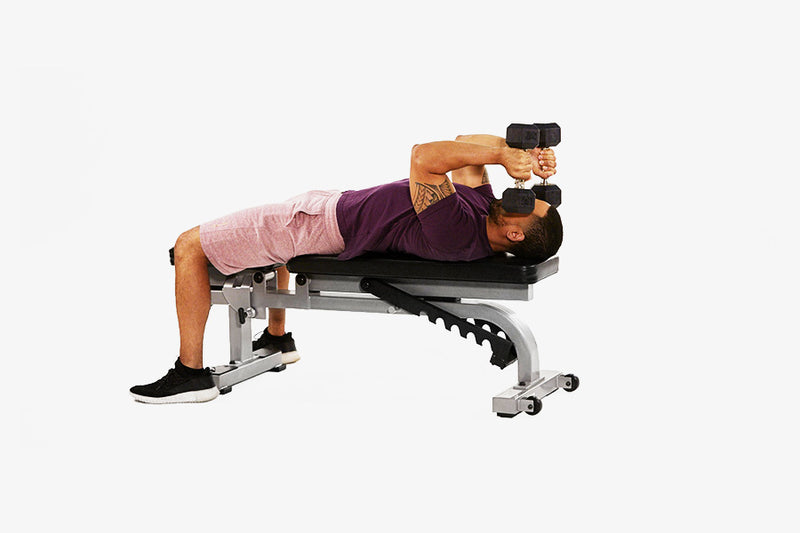
Exercise Description Main Target Muscles Lats, chest Secondary Target Muscles Triceps Workout Type Strength Gym Gear Dumbbell Fitness Level Intermediate Compound/Isolated Isolated Power Move Push Target Muscles: Chest, Back Dumbbell Pullover Overview A dumbbell pullover plays a great role in building your chest muscles. It also helps target your lats and builds upper body strength. It is best to include this exercise in your upper body routine as it utilizes multiple muscle groups. When you are doing a dumbbell pullover, then it is ideal to select a weight that seems comfortable to you. Do not use excessive weight on the first go. Increase the weight gradually once you have established your resistance. How to Do It Sit on the end of the bench with your feet pressed in the ground. Hold a dumbbell in each hand and roll back so that you are lying on the floor. Press your head to the bench. Do not strain your neck. Extend your arms, over your chest, and towards the ceiling. Give a slight bend to your elbows, with your palms facing each other. Extend the weights back over your head and inhale. Keep your core engaged and back in contact with the bench. Fully extend your arms behind. But, weights should not be below your head. Exhale and return the weights to the starting position. Dumbbell Pullover Tips The dumbbell should not go below your head. Keep a controlled movement and do it slowly.
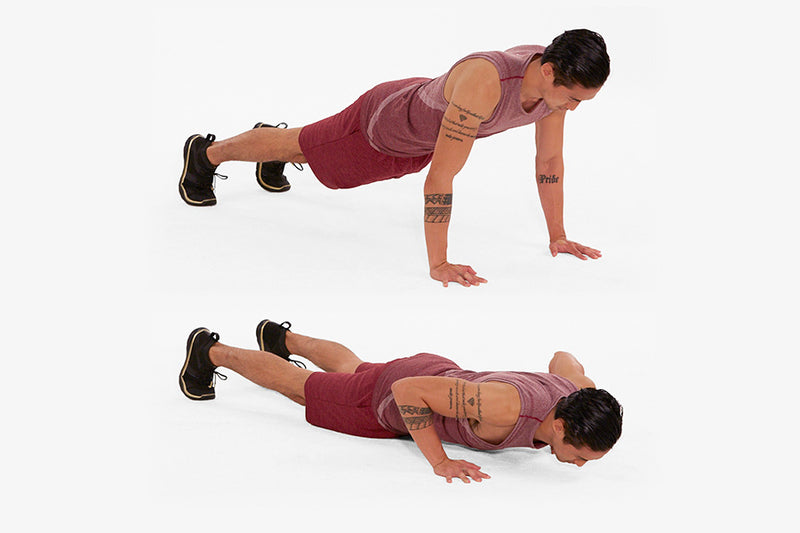
Exercise Description Main Target Muscles Chest Secondary Target Muscles Abs, Triceps, Shoulders Workout Type Strength Gym Gear Bodyweight Fitness Level Beginner Compound/Isolated Compound Power Move Push Target Muscle Group: Chest Push-Up Overview Push-ups are a great way to work your chest, shoulders, and triceps. They are also a good way to work your core muscles. Push-ups are a great exercise for beginners because they are relatively easy to do and they can be done almost anywhere. Push-ups can be included in your chest exercises, upper-body workouts, and full-body workouts. How to Do It Start in a plank position with your hands directly under your shoulders and your feet hip-width apart. Lower your body down toward the ground, keeping your elbows close to your sides. Once your chest touches the ground, press back up to the starting position. Repeat for the desired number of reps Push Up Tips First, be sure to keep your core engaged throughout the entire movement. This will help you maintain good form and prevent your lower back from sagging. Focus on keeping your elbows close to your sides as you lower down—this will help work your triceps more effectively. Be sure to exhale as you push back up to the starting position. This will help you keep your energy levels up and prevent you from holding your breath.
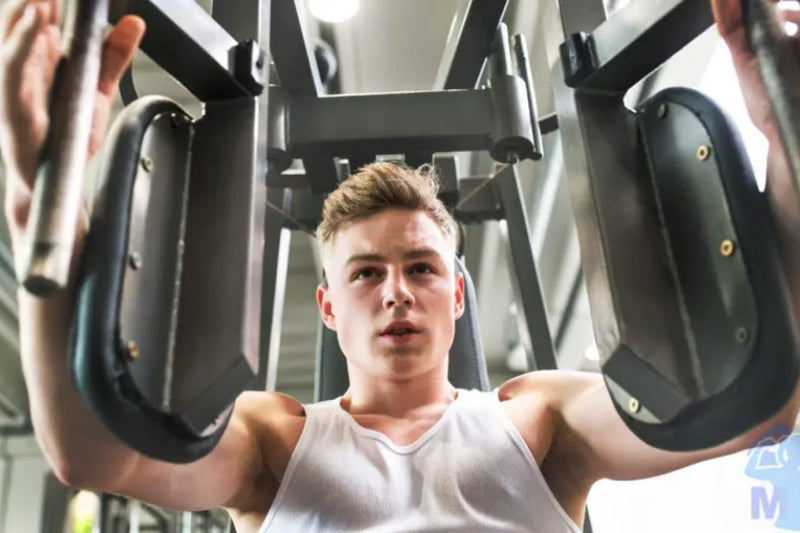
Exercise Description Main Target Muscles Chest Secondary Target Muscles Shoulders Workout Type Strength Gym Gear Chest Fly Machine Fitness Level Beginner Compound/Isolated Isolation Power Move Push Target Muscle: Chest Machine Chest Fly Overview The fly machine is ideal workout equipment to build chest strength and increase muscle mass. If your main objective to do this is to build your pecs, then you'd achieve the desired results efficiently with this workout. The best part about the machine chest fly is that you don’t have to worry about Maintaining Stability or balance throughout the exercise. For a beginner who has just begun working on his chest muscles would find the exercise to benefit him massively through the daily chores. How to Do It You will use the chest fly machine for this workout. Adjust the height of the seat in such a way that when you sit, your arm pads should be at the level of your chest. Select the weight from the rack. Sit on the machine, grab the handle, and take the weight off. Here’s your starting position for the exercise. Slowly bring your forearms together without letting them touch. Keep your body still. Count till 3 and squeeze the chest muscles, then return to the starting position. Repeat for the desired number of reps. Machine Chest Fly Tips Keep your body still throughout the exercise, and do not touch the handles in the center. Make sure not to extend your torso forward when squeezing the weight up. Squeeze the chest at the top of the exercise to increase the intensity. Keep your upper arms parallel to the floor. Related Article: Standing Chest Fly
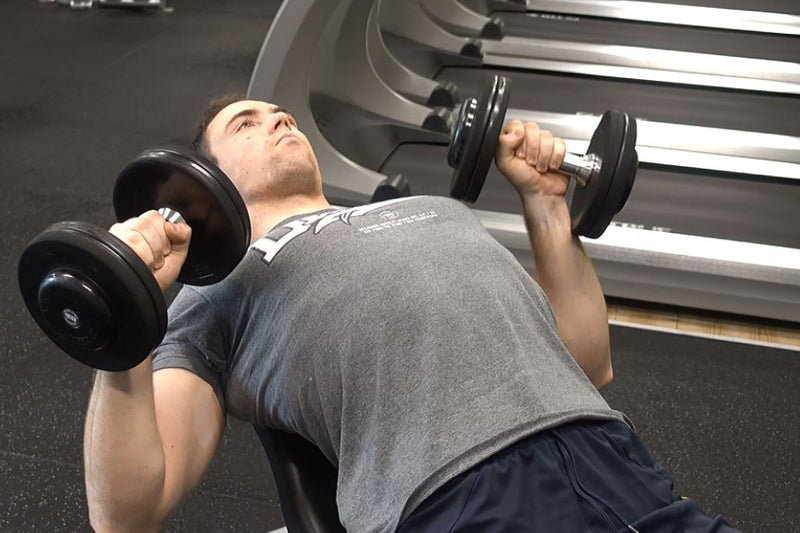
Exercise Description Main Target Muscles Chest Secondary Target Muscles Shoulders, Triceps Workout Type Strength Gym Gear Dumbbell Fitness Level Beginner Compound/Isolated Compound Power Move Push Target Muscle: Chest Dumbbell Bench Press Overview The dumbbell bench press is a phenomenal exercise performed to target the chest muscles. It is a variation of barbell bench presses. Dumbbell bench presses are always recommended after performing the barbell bench press. This is to allow the body to develop a specific level of strength that keeps it from suffering shoulder injuries. The weight you lift should be a very conscious decision in this case. Ensure to pick a weight that aligns with your physical capacity in order to maintain shoulder stability and avoid injuries. Variations of this exercise include: Inclined barbell bench press Inclined dumbbell bench press Close grip bench press How to Do It Pick the pair of dumbbells in your hands, keep a neutral grip and sit down on the bench. Lay down on your back on the bench and hold the dumbbells close to your chest. Now raise your arms and, almost locking your elbows, hold the dumbbells straight over your head. Slowly lower the dumbbells about the level of your chest. Contracting the chest muscles, push the dumbbells back to the starting position. Repeat for the desired number of reps. Dumbbell Bench Press Tips Throughout the exercise, keep your chest muscles tense and do not completely lock your elbows. Hold the weights at a tilted angle of 45 degrees in order to keep your elbows in a neutral position. Make sure your dumbbells don’t bounce or collide with each other as it can cause you to lose stability. Your shoulder blades should be contracted together. Keep your abs braced throughout. The lower body should not move throughout the movement.
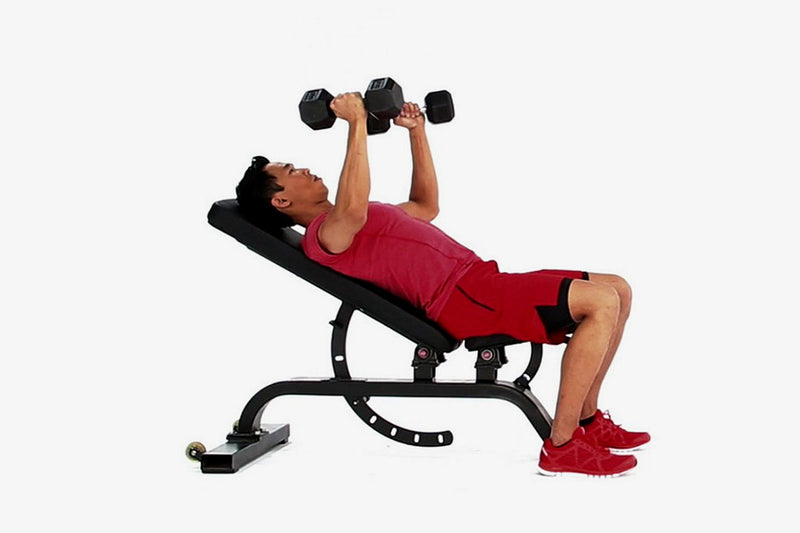
Exercise Description Main Target Muscles Chest Secondary Target Muscles Triceps Workout Type Strength Training Gym Gear Dumbbell Fitness Level Intermediate Compound/Isolated Compound Power Move Push Target Muscles: Chest Incline Dumbbell Press Overview The incline dumbbell press is a variation of the traditional bench press. It specifically targets your chest muscles and gives you a massive challenge. The incline in this variation adds more intensity which helps in targeting the chest muscles. Usually, lifters face hard working their chest muscles, but they can get better at targeting it with an incline dumbbell press. The use of dumbbells in this exercise helps develop strength among both sides of the chest and promotes balance. It also prevents developing different shoulder injuries. Select a weight that you feel comfortable with. Ensure to maintain your technique throughout the exercise. How to Do It Adjust the level of the bench to a level of 15 to 30 degrees. Sit on the bench and place two dumbbells by your side. Lie back and hold the dumbbells. This will be your starting position. Engage your core and press the dumbbells towards the ceiling. Your palms should be facing forward and rotating your shoulder outwards to engage your back muscles. Lower the dumbbell slowly until your upper arm is slightly below your back. Your elbows will be making an angle of 45 degrees to your torso. Pause here for a second. Your waist and back should be neutral. Incline Dumbbell Press Tips Keep your shoulder blades in one place and together to ensure a safe position. Maintain tension in pecs, and do not lock your elbows. Do not allow your back to arch and engage your abs throughout the exercise. Keep your feet on the ground and do not lift them. Do not allow the colliding of dumbbells at the top to ensure your safety.
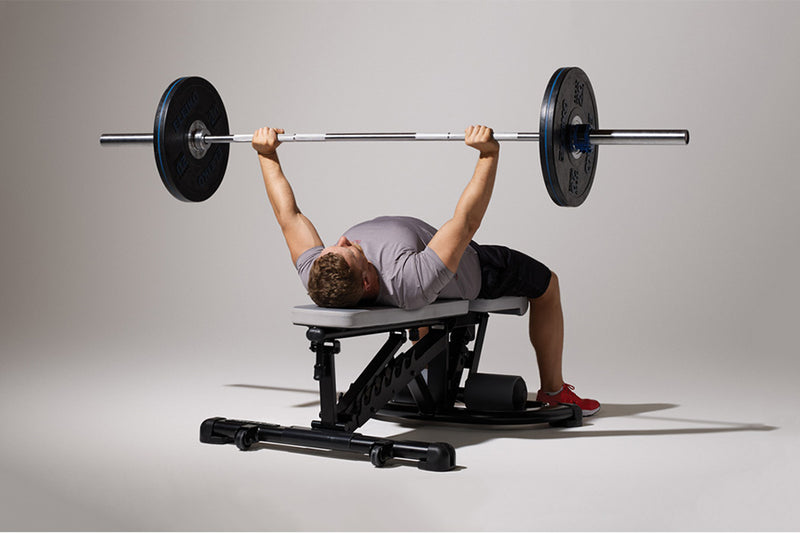
Exercise Description Main Target Muscles Chest Secondary Target Muscles Triceps, Shoulders Workout Type Strength Training Gym Gear Barbell/ Dumbbell Fitness Level Intermediate Compound/Isolated Compound Power Move Push Target Muscles: Chest muscles Bench Press Overview The bench press is one of the most common exercises that almost all weightlifters know. It is the best exercise to target the chest muscles, and hence it is part of all chest workouts. It targets many muscles of your upper body and develops strength. Majorly, the exercise works your chest muscles, but to move the equipment, your body uses other muscles such as the chest, triceps, and shoulders. Since it is a comparatively difficult exercise and many might find it hard to get a perfect grip on exercise, it is better to start with different variations. You can also use a pair of dumbbells instead of a barbell to do the bench press. How to Do It Lie flat on the bench with your feet pressed to the floor and hands outside the shoulder-width. Your shoulder blades must be in contact with the bench and pinched together. While breathing, lift the weight and maintain tightness in your upper back. At this point, make sure that your upper back is tight. Bring the bar towards your chest while inhaling and unlocking the elbows. Push it back and press yourself on the bench for the remaining reps. Bench Press Tips It is better to start slow with the bench press. Learn the technique first and then proceed with the exercises. Keep the bar straight in line with your wrists, ensure that it is straight while you lower it. Do not arch your lower back, or you might be at risk of developing injuries. Make sure that bar is touching your chest in every rep. The glutes and shoulder blades should be in contact with the bench throughout the exercise. Push your feet to the ground and avoid lifting them. Do not rush and aim for controlled movement. Maintain the tightness in your back throughout the movement. Practice with a dumbbell first and then move to the barbell.
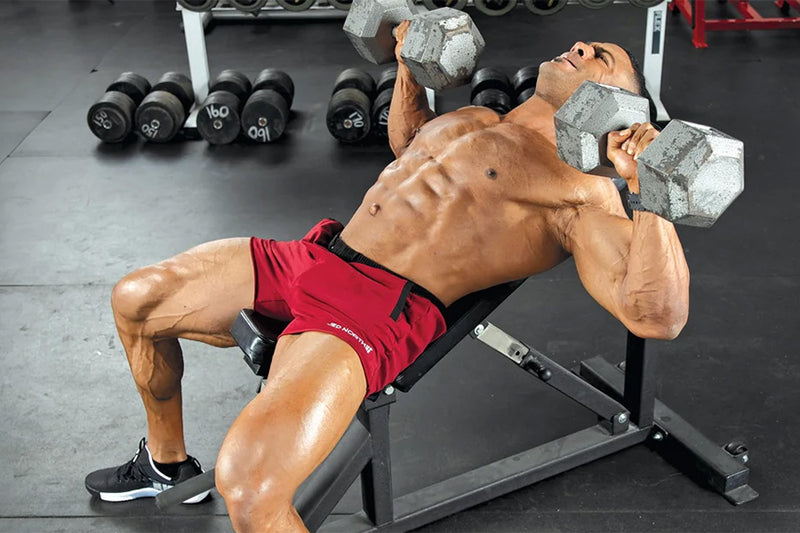
Exercise Description Main Target Muscles Pectoral (Chest) Muscles Secondary Target Muscles Deltoids and Triceps Workout Type Strength Gym Gear Dumbbell Fitness Level Intermediate Compound/Isolated Isolation Power Move Push Incline Dumbbell Bench Press Overview The incline dumbbell bench press is a variation of the incline bench press which primarily builds chest muscles. Shoulder and triceps muscles will also benefit from this exercise. Using an inclined position lets you target the upper part of the chest harder- a part that is usually ignored in most weightlifting exercises. Use of dumbbells means safety and muscular stability. How to Do It Sit down on the edge of an incline bench with dumbbells in your hand with a neutral grip. Lay back, keeping the weights close to your chest. Once you are ready, press the weight upwards stretching out your arms fully. Lower the dumbbells slowly, in a controlled fashion. Engage your chest muscles and push the weights back up to the starting position. Repeat as many times as you can. Tips on Incline Dumbbell Bench Press Try to keep your arms straight as you press the weights up. Do not let dumbbells collide at the top position because that can disrupt your balance. Engage your abs during the exercise. Maintain proper form and avoid pressuring your lower back.
